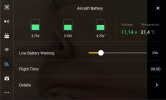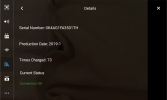- Joined
- Nov 4, 2017
- Messages
- 13
- Reactions
- 11
- Age
- 71
? 1 ... a LiPo battery will start to lose capacity as soon as you start to use it.Can someone tell me how many times I can charge my batteries before they loose power
Percentage is just an approximation. The best way to watch your battery is "cell voltage". You can turn on that option in battery settings. It shows the voltage of lowest cell in real time. I use 3.6 volts as my lower limit regardless of what is displayed % wise. When I his 3.6 volts I bring it down and swap to another battery. I also deep discharge every so often (5% or less) then after completely cool, recharge to 100%. That will help keep cells balanced.And let them sit on the approx 50% automatic discharge when not using them.
Keeping them stored too high or too low a %, and high temps / heat are the 2 big lipo killers.
I like to fly them down to no more than 20% usually, with an occasional deep discharge to maybe 5% every 10 flights or so.
Put them on charge at least an hour after a flight so they are well cooled down.
I just take them off when the 3rd battery light starts flashing, if not flying again soon.
Yeah ... you're totally correct, it's the cell voltages that matters....The best way to watch your battery is "cell voltage". You can turn on that option in battery settings. It shows the voltage of lowest cell in real time...

This is a common misunderstanding ... the cells will always be balanced voltage wise as a part of the charge procedure in the end of every full charge, you don't have to deep discharge them in order to get the individual cells to be balanced ... if it was as you say it would be a battery failure nearly every flight as the cells then wouldn't be balanced... besides when you do this "deep discharge/full charge cycle.I also deep discharge every so often (5% or less) then after completely cool, recharge to 100%. That will help keep cells balanced.
I am not sure about Android, but even with iOS you have to turn on this feature in you battery settings. It is not there until you turn it on. Maybe Android is different, but don't see any reason you could not use this feature. I have Crystalsky so do not use a phone for my monitor.Yeah ... you're totally correct, it's the cell voltages that matters.
But as this thread started out in regards to a Mavic Pro which uses the DJI GO4, the functionality you speak of that shows the lowest cell voltage directly in the upper right corner in the live view only works on the iOS version not on Android.
View attachment 134248
This is a common misunderstanding ... the cells will always be balanced voltage wise as a part of the charge procedure in the end of every full charge, you don't have to deep discharge them in order to get the individual cells to be balanced ... if it was as you say it would be a battery failure nearly every flight as the cells then wouldn't be balanced... besides when you do this "deep discharge/full charge cycle.
Instead this procedure originate from the time when the Battery Management Systems wasn't as reliable as they are today. In the past the BMS "drifted" with every charge cycle, eventually ended up not showing the percentage in a reliable way. To remedy this a BMS calibration was necessary & was performed as you describe. After the calibration the BMS again showed 100% when the battery actually was full.
Nowadays the BMS units are much more reliable & rarely drift noticeable ... so a calibration is usually not needed. If doing it anyway on a repetitive basis ... the only thing you will achieve is that you waste charge cycles from the battery.
Yeah... Android is different, only the iOS version of the recent GO4 have it unfortunately, nothing to turn on plain & simple.I am not sure about Android, but even with iOS you have to turn on this feature in you battery settings. It is not there until you turn it on...
Thanks, I guess. Sorry to hear Android does not have this option. I rely on it showing actual battery voltage and know when to land and swap battery so I do not damage them.Yeah... Android is different, only the iOS version of the recent GO4 have it unfortunately, nothing to turn on plain & simple.
I use 3.6 volts as my lower limit regardless of what is displayed % wise. When I his 3.6 volts I bring it down and swap to another battery.
Good job, mate! These batteries are finicky if they are taken out of their comfort zone.I'll keep an eye on that as using Go4 I do have the cell V showing.
Will be interesting to see where the 3.6v sits on the % scale.
With a fully charged battery with well balanced cells from the beginning & a reasonably smooth flight (not a lot of voltage sags & recovery phases) 50% is a tad over 3,7V, 30% a tad over 3,6V & 10% very close, but above 3,5V. And the further down you go percentage wise the voltage will fall very little ... at 5% the voltage is 3,5V or just below. I imagine that the huge drop in the end regarding cell voltage (characteristic for a LiPo) occurs when the BMS is reporting 0%....Will be interesting to see where the 3.6v sits on the % scale.
Android is all I use and yes sir, it does have that functionality. My display looks exactly like the red-circled part of your screenshot. I keep it turned on at all timesthe functionality you speak of that shows the lowest cell voltage directly in the upper right corner in the live view only works on the iOS version not on Android.
Do you use the latest version of GO4? ... If yes, then it's even more differences regarding the GO4 appearance, then it's also model dependent.Android is all I use and yes sir, it does have that functionality. My display looks exactly like the red-circled part of your screenshot. I keep it turned on at all times


Then I apologize for not knowing that... had no idea the screens would be different on different models. The only mavic experience I have is the MPP.then it's also model dependent.
Wonder why in the world DJI would do that? If that option is possible on iOS then it's possible on Android. IMO that is a very important option, and to leave it off the Android version is negligent. Even Android Go3 has that option.With Android no setting under the battery section to turn the live screen lowest cell voltage on ... (but it is if running iOS)
Yeah ... it's always been differences between the different OS but it never have been any logic behind it. Agree with you, in this case it's a safety functionality.Wonder why in the world DJI would do that? If that option is possible on iOS then it's possible on Android. IMO that is a very important option, and to leave it off the Android version is negligent. Even Android Go3 has that option.
As per me max recharge are 120-150...DJI always over throttle The battery to reduce weight? 1 ... a LiPo battery will start to lose capacity as soon as you start to use it.
DJI batteries are normally rated for something between 200-300 cycles (that's what usually is stated in the battery warranty as max # cycles) but that doesn't mean that they haven't deteriorated capacity wise... or are unusable.
Furthermore charge cycles usually aren't what's generating the most wear on your batteries ... it's how you have used them & stored them.
We use essential cookies to make this site work, and optional cookies to enhance your experience.


